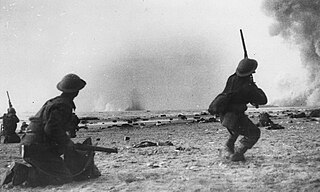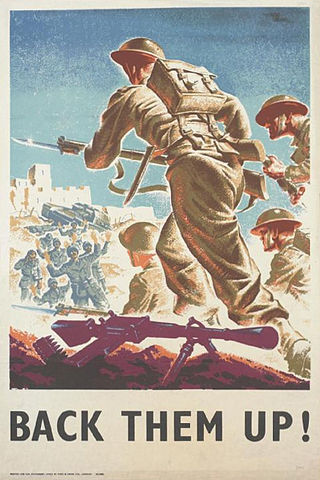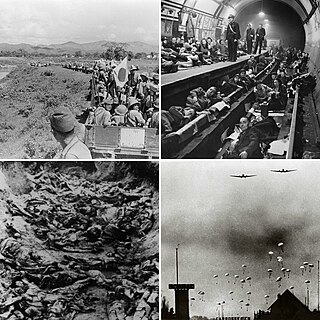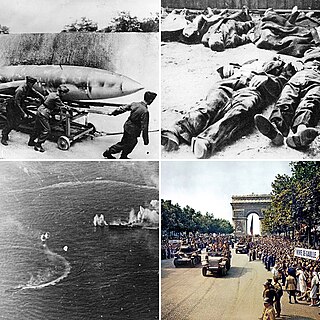
The Battle of Dunkirk was fought around the French port of Dunkirk (Dunkerque) during the Second World War, between the Allies and Nazi Germany. As the Allies were losing the Battle of France on the Western Front, the Battle of Dunkirk was the defence and evacuation of British and other Allied forces to Britain from 26 May to 4 June 1940.

The military history of the United Kingdom in World War II covers the Second World War against the Axis powers, starting on 3 September 1939 with the declaration of war by the United Kingdom and France, followed by the UK's Dominions, Crown colonies and protectorates on Nazi Germany in response to the invasion of Poland by Germany. There was little, however, the Anglo-French alliance could do or did do to help Poland. The Phoney War culminated in April 1940 with the German invasion of Denmark and Norway. Winston Churchill became prime minister and head of a coalition government in May 1940. The defeat of other European countries followed – Belgium, the Netherlands, Luxembourg and France – alongside the British Expeditionary Force which led to the Dunkirk evacuation in June 1940.

The Dunkirk evacuation, codenamed Operation Dynamo and also known as the Miracle of Dunkirk, or just Dunkirk, was the evacuation of more than 338,000 Allied soldiers during the Second World War from the beaches and harbour of Dunkirk, in the north of France, between 26 May and 4 June 1940. The operation commenced after large numbers of Belgian, British, and French troops were cut off and surrounded by German troops during the six-week Battle of France. In a speech to the House of Commons, British Prime Minister Winston Churchill called this "a colossal military disaster", saying "the whole root and core and brain of the British Army" had been stranded at Dunkirk and seemed about to perish or be captured. In his "We shall fight on the beaches" speech on 4 June, he hailed their rescue as a "miracle of deliverance".
Mass evacuation, forced displacement, expulsion, and deportation of millions of people took place across most countries involved in World War II. A number of these phenomena were categorised as violations of fundamental human values and norms by the Nuremberg Tribunal after the war ended. The mass movement of people – most of them refugees – had either been caused by the hostilities, or enforced by the former Axis and the Allied powers based on ideologies of race and ethnicity, culminating in the postwar border changes enacted by international settlements. The refugee crisis created across formerly occupied territories in World War II provided the context for much of the new international refugee and global human rights architecture existing today.

Admiral Sir Bertram Home Ramsay, KCB, KBE, MVO was a Royal Navy officer. He commanded the destroyer HMS Broke during the First World War. In the Second World War, he was responsible for the Dunkirk evacuation in 1940 and planning and commanding the naval forces in the invasion of France in 1944.

Almost every country in the world participated in World War II. Most were neutral at the beginning, but only a relative few nations remained neutral to the end. The Second World War pitted two alliances against each other, the Axis powers and the Allied powers; the Soviet Union mobilised 34 million men and women, Germany 18 million, the U.S 16 million, Japan 9 million, and Great Britain 6 million. It is estimated that in total, 126 million people were mobilised during the war. It is generally estimated that a total of 72 million people died, with the lowest estimate being 40 million dead and the highest estimate being 90 million dead. The leading Axis powers were Nazi Germany, the Empire of Japan and the Kingdom of Italy; while the British Empire, the United States, the Soviet Union and the Republic of China were the "Big Four" Allied powers.
The Timeline of the Battle of France, also known as the Fall of France, covers the period during World War II from the first military actions between Germany and France and to the armistice signed by France. Over the period of six weeks, from May 10 to June 25, 1940, Nazi Germany had also conquered Belgium, Netherlands and Luxembourg. Nazi Germany's overall plan was to invade the Low Countries which would make the French and British troops leave their current position and position their forces in Belgium. Then, a second force would navigate through the Ardennes Forest and move around the Maginot Line at the weakest part of the Allied defences. The force would then move towards the west French coast and cut the northern Allied force off. The Germans would then capture Paris, eliminate any resistance that remained, cross the English Channel, and invade the United Kingdom.
Battle Honours are awarded by the Sovereign to Royal Air Force squadrons to commemorate the squadron's role in a particular operation.

MTB 102 is one of few surviving motor torpedo boats that served with the Coastal Forces of the Royal Navy in the Second World War. She was built as a prototype, but was purchased and taken into service by the Admiralty.

Forced labor of Germans in the Soviet Union was considered by the Soviet Union to be part of German war reparations for the damage inflicted by Nazi Germany on the Soviet Union during the Axis-Soviet campaigns (1941-1945) of World War II. Soviet authorities deported German civilians from Germany and Eastern Europe to the USSR after World War II as forced laborers, while ethnic Germans living in the USSR were deported during World War II and conscripted for forced labor. German prisoners of war were also used as a source of forced labor during and after the war by the Soviet Union and by the Western Allies.

This is a timeline of World War II events that took place in 1940, the first full year of the second global war of the 20th century.

This is a timeline of events that occurred during 1944 in World War II.
Dunkirk is a 2004 BBC Television factual about the Battle of Dunkirk and the Dunkirk evacuation in World War II.

In Soviet historiography, Stalin's ten blows were the ten successful strategic offensives conducted by the Red Army in 1944 during World War II. The Soviet offensives drove the Axis forces from Soviet territory and precipitated Nazi Germany's collapse.
Major General Ridley Pakenham Pakenham-Walsh, was a senior British Army officer who served as Engineer-in-Chief of the British Expeditionary Force in the Battle of France and later as General Officer Commanding Northern Ireland District and IX Corps.

HMS Sabre was an Admiralty S-class destroyer of the Royal Navy launched in September 1918 at the close of World War I. She was built in Scotland by Alex Stephens and completed by Fairfield Shipbuilding and Engineering Company in Govan. Commissioned for Fleet service in 1919, she was the first Royal Navy ship to carry this name.

HMS Vivacious (D36) was a V-class destroyer of the British Royal Navy that saw service in World War I and World War II.

HMS Venomous (ex-Venom), was a Modified W-class destroyer of the British Royal Navy that saw service in the Russian Civil War and World War II.

The third HMS Windsor (D42) was a W-class destroyer of the British Royal Navy that saw service in the final months of World War I and in World War II.













